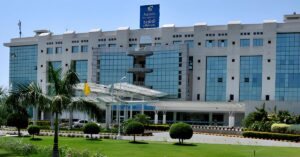Best Doctors in India for IMRT
Best Hospitals in India for IMRT
- City: Mumbai, India
Hospital Highlights:
- Fortis Hiranandani hospital was established in 2007.
- The hospital is an advanced tertiary care, multi-specialty hospital equipped with 149 beds.
- The hospital is equipped with a super ICU to provide emergency medical care to critically ill patients.
- The hospital is NABH accredited.
- The critical care facility in the hospital is augmented with the state-of-the-art facilities that facilitate speedier diagnosis and efficient monitoring.
- The hospital provides specialty medical services in cardiology, orthopedic science, pediatric science, neurology, diabetic care, urology, nephrology, ENT, obstetrics, gynecology, cosmetic surgery, bariatric surgery, neuro and spine care.
- City: Gurugram, India
Hospital Highlights:
- W Pratiksha Hospital, Gurugram, is one of the best hospitals in the NCR region. It is also a top hospital in India for IVF. Since its inception, the hospital has performed over 5500 successful IVFs. The hospital also specializes in gynecology.
- With over 20 years of experience in providing quality healthcare, the hospital is known as one of the most trusted and valued health providers in India.
- Equipped with world-class medical facilities and advanced technology, the hospital’s doctors and clinicians also have a track record of delivering excellent results. The hospital is also known for focusing on preventive well-being as much as on curative treatment.
- The hospital has earned the trust of its patients, by providing the best available treatments at affordable costs.
- City: Gurugram, India
Hospital Highlights:
- Paras hospital was established in 2006 and is the 250 bedded flagship hospital of Paras Healthcare.
- The is supported by a team of doctors of international and national repute.
- The hospital is NABH accredited and also the first hospital in the region to have a NABL accredited laboratory.
- The hospital provides specialty medical services in around 55 departments including Neurosciences, Joint Replacement, Mother & Child Care, Minimal Invasive Surgery, Gynecology and Obstetrics, Ophthalmology, Dermatology, Endocrinology, Rheumatology, Cosmetic and Plastic surgery.
- The hospital is equipped with state-of-the-art technologies.
- City: Kolkata, India
Hospital Highlights:
- Fortis Hospital, Anandapur, Kolkata is a world-class super-speciality equipped with the latest technologies in the medical world.
- The hospital is NABH accredited.
- This state-of-the-art facility specializes in cardiology and cardiac surgery, urology, nephrology, neurosciences, orthopaedics, digestive care, emergency care and critical care.
- The hospital, governed by integrated Building Management System (IBMS), has a pneumatic chute system, for quick vertical and horizontal transportation between floors, facilitating speedy transfer of patient specimens, documents, reports, and medicines to the concerned departments.
- The hospital also has a nephrology department with over 28 advanced dialysis units.
- City: Mumbai, India
Hospital Highlights:
- SL Raheja hospital is a 140-bed multi-specialty tertiary care hospital that is being managed by Fortis Healthcare Ltd.
- The hospital is a benchmark in healthcare and medical facilities in the neighborhood of Mahim & the western suburbs.
- L.Raheja Hospital, Mahim has one of the most effective ICU and Casualty care services.
- The hospital provides specialty medical services in Cardiology, Oncology, Neurology, Orthopedics, Mother & Child Care, and in Diabetes.
- City: Mumbai, India
Hospital Highlights:
- Wockhardt Hospitals were established in the year 1973, originally called First Hospitals and Heart Institute.
- Wockhardt Hospitals are super specialty health care networks in India, nurtured by Wockhardt Ltd, India’s 5th largest Pharmaceutical and Healthcare company.
- Wockhardt Hospitals is associated with Partners Harvard Medical International, an international arm of Harvard Medical School, USA.
- Wockhardt Heart Hospital performed India’s first endoscopic heart surgery.
- The hospital has a state-of-the-art infrastructure equipped with the latest technologies and modern equipment.
- It has special Centers of Excellence dedicated to the major specialties to provide hassle-free and high-quality clinical care.
- City: Gurugram, India
Hospital Highlights:
- The CK Birla Hospital in Gurugram is a NABH-accredited multi-specialty hospital.
- The hospital strives to increase the quality of healthcare by focusing on UK NHS nurse and midwife training requirements. Policies and practices derived from the National Institute for Health and Treatment Excellence (NICE) recommendations in the United Kingdom ensuring that a strong focus on safety, high-quality clinical care, and sanitation is maintained.
- The hospital’s cutting-edge technology and facilities allow for real-time communication and seamless collaboration among caregivers, ensuring accuracy and the best possible results. Those with foreign experience and accreditations make up part of the hospital’s team of clinicians.
- City: Ahmedabad
Hospital Highlights:
- As a member of the Apollo Hospitals Group, Apollo Hospitals International Limited, Ahmedabad is one of the most popular and sought-after medical facilities in Gujarat.
- Through its 6 Centres of Excellence and various affiliated branches, which cover all specialties and subspecialties, the hospital provides the most advanced clinical services.
- Since its inception in 2003, the hospital has been providing each patient with the most up-to-date medical equipment and state-of-the-art technology.
- With more than 150 successful organ transplants, including liver and renal transplants, the facility has been able to build a strong and extensive organ transplant program.
- In addition to performing 600 surgeries and caring for over 1800 patients on an IP basis, the hospital sees more than 18,000 patients on average in the outpatient department.
- With one of the biggest cardiology teams in the area, the hospital provides state-of-the-art regional care treatment in Cardiac Sciences.
- Additionally, the hospital offers a broad range of Neuro Interventional techniques to help stroke patients recover more quickly.
- City: Noida, India
Hospital Highlights:
- Jaypee Hospital is the flagship hospital of the Jaypee Group.
- This hospital has commissioned 525 beds in the first phase and has been planned and designed as a 1200 bedded multi-specialty facility.
- It holds the accreditation of the NABH and NABL.
- The hospital has state-of-the-art infrastructure equipped with the latest technologies and modern equipment like 64 Slice PET CT, Dual Head 6 Slice SPECT CT, Gamma Camera, and Da Vinci Robotic Surgery for comprehensive robotic surgical solutions.
- It has special Centers dedicated to the major specialties to provide hassle-free and high-quality clinical care.
- City: Mumbai, India
Hospital Highlights:
- Reliance Hospital is one of the best super-specialty care hospitals in Navi Mumbai.
- The main purpose of this hospital is to become a trustworthy place for the best health and hope for society. The hospital is well connected to the suburbs of Mumbai and Navi Mumbai.
- The hospital has various specialty departments, viz., Accident & Emergency, Anesthesiology, Dental Services, Dermatology, Diabetology, Dietetics Nutrition, Endocrinology, ENT, Gastroenterology, General Surgery, Gynaecology And Obstetrics, Hepato Pancreato Biliary Surgery, Infectious Disease, Internal Medicine, Interventional Radiology, Laboratory Medicine, Minimal Access Laparoscopic Surgery, Nephrology, Neurosciences, Opthalmology, Orthopaedics, Paediatrics, Pain Management Palliative Care, Physical Medicine Rehabilitation, Plastic And Reconstructive Surgery, Psychiatry, Pulmonary Medicine, Radiology, Rheumatology, Transplant, Urology Andrology, Vascular Surgery
IMRT
Intensity-modulated radiation therapy, known as IMRT, is an advanced type of radiation therapy, which is used for treating cancer as well as noncancerous tumors. This procedure uses advanced technology in order to manipulate photon and proton beams of radiation to conform to the shape of a tumor. The goal of the procedure is to conform the radiation dose to the target while avoiding or reducing exposure of healthy tissue to limit the side effects of treatment.
Purpose
The procedure is used mostly to treat prostate cancer, head and neck cancers, gastrointestinal and gynecologic cancers, brain tumors and lung cancers, among others.
Doctors generally consider this procedure when a tumor partially surrounds or is close to a healthy part of your body that cannot tolerate the full dose of radiation being given to the tumor. When the tumor is not near any sensitive area, IMRT might not be required. You can talk in detail with the radiation team regarding which type of treatment is best for you.
Preparation
Before the treatment, doctors need to conduct a physical examination and medical history. After this is done, there is a treatment simulation session, which might include a CT scan. A small mark or a tattoo might be placed on the skin of the patient, as this can help to align and target the equipment. This radiation oncologist can use this scan to make an individual plan for the patient.
Sometimes it might be important to follow a certain bowel and bladder preparation regimen, or too fast, before the simulation and treatment. The patient might be injected with intravenous contrast material, during the CT scan, as it can help to define the tumor better.
Sometimes additional scanning procedures, which include magnetic resonance imaging (MRI), or positron emission tomography (PET) might also be required for IMRT planning. These diagnostic images can be merged with the planning CT, to help the radiation oncologist determine the exact location of the tumor target.
Sometimes it is also necessary to insert radiodense markers into the target for more accurate positioning. In general, IMRT sessions usually begin around a week or two after the simulation.
The team involved in this procedure generally includes the medical oncologist, medical physicist, radiation therapist, dosimetrist, and radiation therapy nurse.
Procedure
Generally, IMRT often requires multiple treatment sessions on different days. The radiation oncologist will consider the type, location and size of the tumor, doses to normal structures, as well as the health of the patient, to decide the number of treatment. Generally, patients are scheduled for IMRT sessions five days a week for about a month or two.
At the beginning of each session, first, the radiation therapist will position the patient on the treatment table, guided by the marks on the skin, i.e. tattoos that help identify the treatment area. If there were molding devices made, then they will be used to help the patient maintain a proper position. The patient might be repositioned during the procedure as well. Imaging systems on the treatment machine such as X-ray or CT might be used for checking positioning and marker location.
After the patient is positioned, the radiation will be turned on for a brief time. For each position of the machine, the radiation is on for only a minute or two. During the entire procedure, the machine rotates over you, while you lie as still as you can, breathe normally and relax.
The treatment generally should not take more than 30 minutes.
After the procedure
Risks and complications
Though IMRT has many advantages, it might not always be the best option for patients. Sometimes there are side effects of radiation treatment which may include problems that might occur as a result of the treatment itself as well as from radiation damage to any healthy cells in the treatment area.
The severity of the side effects that you experience can generally depend on the type of radiation and dosage that was prescribed and the part of the body which was being treated. Let your doctor and healthcare team know if you experience any side effects so that they can help you to manage them.
Side effects might be early or in some cases, late. Early side effects generally occur during or immediately after the treatment and should typically go in just a few weeks.
Some of the early side effects of radiation therapy can include tiredness or fatigue as well as skin problems. Skin in the treatment area can sometimes become more sensitive, red, irritated, or even swollen. Other skin changes generally include itching, dryness, peeling, and blistering.
Some of the early side effects may include the following:
- Mouth problems and difficulty swallowing
- Headaches
- Hair loss in the treatment area
- Soreness and swelling in the treatment area
- Eating and digestion problems
- Diarrhea
- Nausea and vomiting
- Urinary and bladder changes
Rarely, late side effects generally occur months or years after the treatment and are generally permanent. They may include:
- brain changes
- spinal cord changes
- colon and rectal changes
- infertility
- joint changes
- lung changes
- kidney changes
- secondary cancer
- lymphedema
- mouth changes
There is also a slight risk of cancer from radiation therapy. Therefore it is important that you are assessed regularly by the radiation oncologist for complications.












